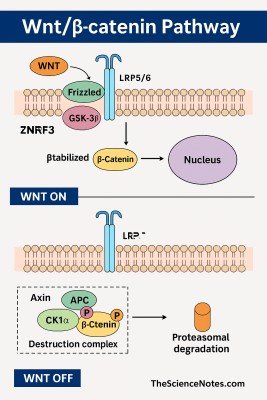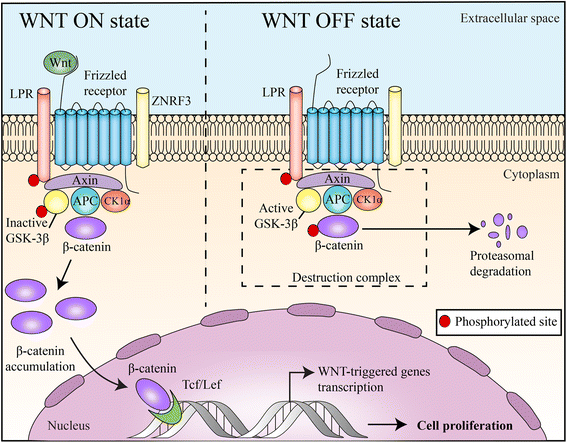Author: Binod G C
Introduction to Wnt/β-Catenin Signaling Pathway
The Wnt/β-catenin signaling pathway, also known as the canonical Wnt pathway, is a highly conserved cellular communication cascade essential for embryonic development, tissue homeostasis, and disease pathology. Dysregulation of this pathway is implicated in many diseases, including colorectal cancer, osteoporosis, and neurodegenerative disorders.
This article provides an in-depth review of the pathway’s molecular components, activation mechanisms, intracellular effectors, and clinical significance, highlighting its relevance in human health and disease.

Pathway Overview: Wnt/β-Catenin Signaling Mechanism
The canonical Wnt pathway is initiated when Wnt proteins, a family of secreted lipid-modified glycoproteins, bind to specific receptors on the cell surface:
Frizzled (FZD) receptors: Seven-transmembrane domain G protein-coupled receptors with extracellular cysteine-rich domains (CRD) for Wnt binding.
LRP5/6 co-receptors: Low-density lipoprotein receptor-related proteins essential for signal transduction.
Additional modulators include:
ROR2 (Receptor tyrosine kinase-like orphan receptor 2)
GPR124
Reck
TMEM59
These proteins fine-tune receptor-ligand interactions and influence signaling specificity across tissues.

Cartoon from : Pai, S. G., Carneiro, B. A., Mota, J. M., et al. (2017). Wnt/beta-catenin pathway: modulating anticancer immune response. Journal of Hematology & Oncology, 10(101). https://doi.org/10.1186/s13045-017-0471-6
Inactive State: Absence of Wnt Ligand and β-Catenin Degradation
Without Wnt ligand binding, cytoplasmic β-catenin is targeted for degradation by the β-catenin destruction complex, which includes:
APC (Adenomatous polyposis coli)
Axin
GSK3β (Glycogen synthase kinase 3 beta)
CK1α (Casein kinase 1 alpha)
PP2A (Protein phosphatase 2A)
β-TrCP (E3 ubiquitin ligase adaptor)
Phosphorylation sequence:
CK1α phosphorylates β-catenin at Ser45.
GSK3β phosphorylates Thr41, Ser37, and Ser33.
β-TrCP recognizes phosphorylated β-catenin and recruits the SCF ubiquitin ligase complex.
Polyubiquitinated β-catenin is degraded by the proteasome.
This tightly regulated process prevents β-catenin nuclear accumulation and inhibits Wnt target gene transcription in the absence of signal.
Active State: Wnt Ligand Binding and β-Catenin Stabilization
Upon Wnt ligand presence:
Wnt binds the CRD of FZD and LRP5/6, forming a receptor complex.
Dishevelled (Dvl) is recruited to the membrane.
Dvl inhibits the destruction complex by promoting Axin recruitment to phosphorylated LRP5/6 tails, leading to complex disassembly.
GSK3β activity is inhibited; Axin levels decrease.
β-catenin stabilizes and accumulates in the cytoplasm, then translocates to the nucleus.
Inside the nucleus:
β-catenin binds TCF/LEF transcription factors.
Co-repressors like Groucho are displaced.
Co-activators such as CBP/p300, BCL9, Pygo, and BRG1 are recruited.
Transcription of Wnt target genes is activated.
Wnt Ligands and Receptors
The mammalian Wnt family includes 19 ligands, with the Wnt1 class (Wnt1, Wnt3, Wnt3a, Wnt8a, Wnt8b) mainly activating the canonical pathway.
FZD receptors (FZD1–10) bind Wnt proteins via CRD.
Regulatory modulators include:
Norrin and Tetraspanin-12: Positive regulators.
sFRPs (secreted Frizzled-related proteins): Inhibit Wnt signaling.
DKK proteins (DKK1–4): Block LRP5/6 to inhibit signaling.
Sclerostin: Antagonizes LRP5.
PORCN (Porcupine): An ER enzyme essential for Wnt ligand palmitoylation and secretion.
Intracellular Signaling Molecules
Key intracellular components include:
β-Catenin: Central effector with domains for phosphorylation and protein interactions.
Axin: Scaffold of the destruction complex.
Dishevelled (Dvl): Multifunctional cytoplasmic protein with DIX, PDZ, and DEP domains.
GSK3β and CK1α: Kinases phosphorylating β-catenin.
β-TrCP: Ubiquitin ligase adaptor.
PP2A: Phosphatase regulating destruction complex activity.
Nuclear Components and Target Genes
β-catenin activates transcription by:
Displacing repressors like Groucho.
Recruiting coactivators (CBP/p300, BCL9, Pygo, BRG1).
Notable Wnt target genes:
Cell cycle regulators: Cyclin D1, c-Myc
Invasion/metastasis markers: MMP7, uPAR, CD44
Transcription factors: TCF1, c-Jun, FRA-1
Others include COX2, Gastrin, PPAR-δ, Fibronectin, Laminin 5 γ2 chain.
Additional Intracellular Regulators
APC: Tumor suppressor linking β-catenin and β-TrCP.
Tankyrases (TNKS1/2): PARP enzymes degrading Axin; inhibition stabilizes Axin and downregulates Wnt.
Chibby and ICAT: Nuclear β-catenin inhibitors.
Axin2: Negative feedback regulator.
WIF1: Sequesters Wnt ligands.
Notum: Removes palmitoleic acid from Wnt, antagonizing signaling.
Pathway Dynamics and Feedback Mechanisms
Positive feedback: Induction of LRP6, FZD receptors.
Negative feedback: Upregulation of Axin2, DKK1, and sFRPs.
Termination mechanisms include receptor endocytosis and proteasomal β-catenin degradation.
Biological and Clinical Importance
Development and Homeostasis
Essential in embryogenesis (axis formation, limb development).
Maintains stem cells in intestinal crypts and hematopoietic niches.
Facilitates tissue repair (skin, liver, bone).
Cancer
Mutations in APC, CTNNB1, and Axin lead to colorectal carcinoma.
Aberrant signaling is implicated in hepatocellular carcinoma, breast, prostate, and lung cancers.
Constitutive activation promotes proliferation, survival, metastasis.
Therapeutic Targeting
PORCN inhibitors (LGK974) block Wnt secretion.
Tankyrase inhibitors stabilize Axin.
CBP/β-catenin antagonists disrupt transcription.
Monoclonal antibodies target FZD or Wnt ligands.
These are in clinical trials for Wnt-driven cancers and fibrotic diseases.
Conclusion
The Wnt/β-catenin signaling pathway is a critical regulator of cell fate, proliferation, and differentiation. Its precise control depends on a complex interplay between extracellular ligands, membrane receptors, intracellular scaffolds, and nuclear transcriptional machinery. Dysregulation contributes to multiple diseases, especially cancer, positioning the pathway as a key focus for therapeutic development.
Ongoing research continues to unravel the pathway’s complexities, offering promising avenues for targeted clinical interventions.
References
Liu, J., Xiao, Q., Xiao, J., et al. (2022). Wnt/β-catenin signalling: function, biological mechanisms, and therapeutic opportunities. Signal Transduction and Targeted Therapy, 7, 3. https://doi.org/10.1038/s41392-021-00762-6
Xue, C., Chu, Q., Shi, Q., et al. (2025). Wnt signaling pathways in biology and disease: mechanisms and therapeutic advances. Signal Transduction and Targeted Therapy, 10, 106. https://doi.org/10.1038/s41392-025-02142-w
Maurice, M.M., Angers, S. (2025). Mechanistic insights into Wnt–β-catenin pathway activation and signal transduction. Nature Reviews Molecular Cell Biology, 26, 371–388. https://doi.org/10.1038/s41580-024-00823-y